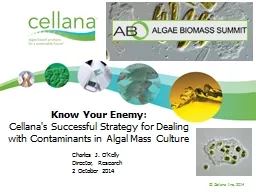

Inc 2014 Know Your Enemy Cellanas Successful Strategy for Dealing with Contaminants in Algal Mass Culture Charles J OKelly Director Research 2 October 2014 Know your enemy OKelly ID: 462536
Download Presentation The PPT/PDF document "© Cellana" is the property of its rightful owner. Permission is granted to download and print the materials on this web site for personal, non-commercial use only, and to display it on your personal computer provided you do not modify the materials and that you retain all copyright notices contained in the materials. By downloading content from our website, you accept the terms of this agreement.
Slide1
© Cellana
Inc. 2014
Know Your Enemy: Cellana's Successful Strategy for Dealing with Contaminants in Algal Mass Culture
Charles J. O’KellyDirector, Research2 October 2014Slide2
Know your enemy – O’KellyAlgae Are Crop Plants
Crops Need Protection From Pests / Disease Slide3
Know your enemy – O’KellyInvesting In Crop Protection
Identification (How accurately? How quickly?)BehaviorPrey rangeVirulenceLife cycleTransmissionVector(s)Susceptibilities
Slide4
Know your enemy – O’KellyInvesting In Crop Protection
Identification (How accurately? How quickly?)BehaviorPrey rangeVirulenceLife cycleTransmissionVector(s)Susceptibilities
The USDA spends ca. US$7MM annually
on the Corn Insects and Crop Genetics Research Unit in Iowa – research focused mainly on a single insect, the corn borer.
European corn borer,
Ostrinia
nubilalis
(larva)Slide5
Know your enemy – O’KellyThe State of Algal Crop Protection
Identification difficult Most identifications crude (“ciliates / rotifers / amoebae / foreign algae”)“Guidebooks” nonexistentCarney & Lane 2014 review: 16 taxa of algivorous protozoa namedonly 9 of the 16 named to species
only 3 of the 16 studied in algal mass culture systems2 of the algal mass culture species new to scienceBehavior and Transmission poorly understood
10 µm
Paraphysoderma
sedebokerense
, a
chytrid
fungus, parasitizing
Haematococcus
. Described 2011. Image: Hoffman Y et al., Mycological Research 112: 70, 2008.Slide6
Crop Protection Case Study
1. IdentificationSlide7
Know your enemy – O’KellyWho’s eating the profits - really
?Culture studies on 5 cell types with ingested algaeNo growth on target alga: one amoeba, two ciliatesSlow growth on target alga: one amoebaRapid growth on target alga: one amoebaConsistent with observations in large-scale productionSlide8
Know your enemy – O’KellyWho’s eating the profits - really
?DNA sequence studies assign amoeba to species Neoparamoeba branchiphilaDescribed in 2005Associated with gills of salmonid fishes affected with
amoebic gill disease (not the cause of the disease)No prior record of algivory for any N. speciesSlide9
Crop Protection Case Study
2A. Behavior – Prey RangeSlide10
Know your enemy – O’KellyNeoparamoeba: gourmet or gourmand?
Susceptible algaeDiatomsSome HaptophytesResistant algaeSome haptophytesGreen algae
EustigmatophytesDinoflagellatesCryptophytesSlide11
Know your enemy – O’KellyNeoparamoeba: gourmet or gourmand?
Grows equally well, or better, on bacteria vs. algaeNot all bacteria support growthVariations between strains
in grazing on both algae and bacteria
Marinobacter
sp. 1
Marinobacter sp. 2Halomonas
sp
.
Nitratireductor
sp
. 1
Labrenzia
aggregata
Roseivivax
sp.
Labrenzia
sp.
Marinobacter
hydrocarbonoclasticus
Sulfitobacter
pontiacus
Nitratireductor
sp
. 2
Nb
O3a
Nb
R1
Nb
K3Slide12
Crop Protection Case Study
2B. Behavior – VirulenceSlide13
Know your enemy – O’KellyComponents of virulence
Grazing rate1-3 prey cells grazer-1 h-1Specific growth rateConsiderably more variability in specific growth rate among
grazers than in grazing rate
Grazing of
Neoparamoeba
(03a, R1, KPF3), Paramoeba (08pp),and Thecamoeba (8t) amoebae on the diatom Skeletonemamarinoi, incubated in the dark at 23 °C. Control: no amoebae.Slide14
Know your enemy – O’KellyThe significance of specific growth rate
Appearance of organisms in batch and semi-continuous culture a function of specific growth rate (initial inoculum a relatively small contributor)Model assumes no loss of cells
Graph at right shows progression of organism with specific growth rate of 2 d-1 and initial inoculum of 0.001
cells L-1
Forehead H, O’Kelly CJ,
Bioresource Technology 129: 329, 2013 Slide15
Know your enemy – O’KellyThe significance of specific growth rate
Neoparamoeba branchiphila on favored prey has specific growth rate ca. 2 d-1Timing of appearance of
N. branchiphila in large-scale production closely followed
model predictionsDashed line shows limit of detection of contaminants via microscopic
monitoring.
Forehead H, O’Kelly CJ,
Bioresource
Technology
129: 329, 2013
Slide16
Crop Protection Case Study
2C. Behavior – Life CycleSlide17
Know your enemy – O’KellyWYSIWYG
A “one-phase” life cycle: trophic cells (amoebae)No cystsNo resting stagesNo obvious sexual reproductionControl the trophs, control the pestSlide18
Crop Protection Case Study
3. Transmission – Vector and SusceptibilitiesSlide19
Know your enemy – O’KellyAirborne or Waterborne?
Airborne transmission of Neoparamoeba?No cystsNo desiccation-resistant stagesNo evidence for amoebae in air column samplesWaterborne transmission of Neoparamoeba?
Ability of amoebae to subsist on bacteria suggests possibility of ‘reservoirs’ Must survive UV, several degrees of water filtrationSlide20
Know your enemy – O’KellyWaterborne!
Up to 12 Neoparamoeba cells per 100 L detected in filtered seawater used in productionOnly 1 cell per 1000 L needed for contamination in 14 days per modelNeoparamoeba cells survived 300 mJ UV in laboratory tests
Production UV was delivering ca. 150 mJSlide21
ActionsSlide22
Know your enemy – O’Kelly
ALDUO™
Closed
System
Photobioreactors
(PBRs)
+
Open
System
Open Raceway Ponds
Clean water
Clean procedures
Resistant strains
Clean water
Clean inoculum
P
ond cycle management Slide23
Know your enemy – O’Kelly
ALDUO™
Closed
System
Photobioreactors
(PBRs)
+
Open
System
Open Raceway Ponds
Clean water
Clean procedures
Resistant strains
Clean water
Clean inoculum
P
ond cycle management
Strategies informed by Knowing The EnemySlide24
Know your enemy – O’Kelly
ALDUO™
Closed
System
Photobioreactors
(PBRs)
+
Open
System
Open Raceway Ponds
Clean water
Clean procedures
Resistant strains
Clean water
Clean inoculum
P
ond cycle management
12 non-extremophile algal strains grown at large scaleSlide25
Thanks to:
Geneva
Mottet Dan Burton Yana Eglit